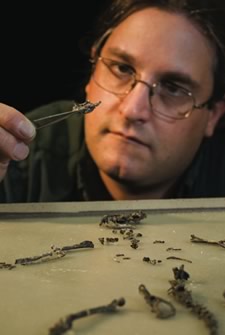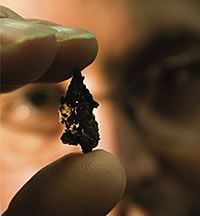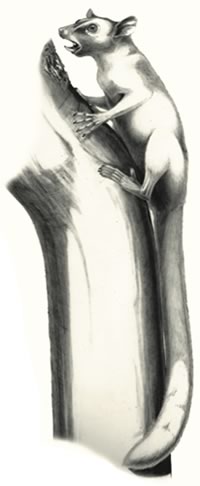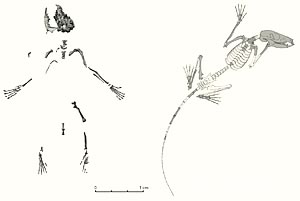The roots of the primate family tree are now more clearly defined in the fossil record, and about 10 million years older than thought, according to Florida Museum of Natural History vertebrate paleontologist Jonathan Bloch and his team of researchers. The team, led by Bloch, is proposing that a group of archaic mammals called plesiadapiforms (please-ee-ah-dape-i-forms) that lived in a slice of time called the Paleocene—between 65 and 55 million years ago, just after the dinosaurs disappeared—are in fact the earliest ancestors of primates.

Photo by Eric Zamora
The evolutionary relationship of plesiadapiforms is a hot-potato topic in the paleontology community, often generating controversy and debate. Some scientists have proposed that they were related to flying lemurs. Others said they were more closely related to primates. But it was conjecture; no one offered strong evidence supporting these arguments.
That is, no one did until Jan. 23 when Bloch and his team published the description of two new remarkably complete Paleocene skeletons and the results of a robust phylogenetic study in the Proceedings of the National Academy of Sciences, where they are the first to offer compelling evidence that plesiadapiforms are more closely related to modern primates than to flying lemurs.
“We threw everything we had at this study,” Bloch said. “It is, to date, the most comprehensive morphological study on Plesiadapiformes. We used a lot more data than has ever been available before, and we analyzed it using modern phylogenetic techniques, which often don’t get used for this question.”
Bloch said his team’s findings unambiguously group plesiadapiforms with modern primates, in a revised definition of “Primates.”
“Under our revised definition of primates, plesiadapiforms represent the first 10 million years of primate evolution,” Bloch said. “Essentially what we are looking at is a new perspective on the structure of the family tree for early primates – and specifically the relationship between living primates and their fossil record.”
The team’s conclusions are based on its examination of specimens representing more than 85 modern and extinct species. The researchers analyzed 173 physical characteristics of modern primates, tree shrews, flying lemurs and plesiadapiform skeletons to determine which species were most closely related. Scientists have known that tree shrews, primates and flying lemurs share a common ancestor but the thorn in their side has been how to classify plesiadapiforms. What were they most closely related to?
Bloch and his team also say that some plesiadapiforms resemble tree-dwelling tree shrews, which hints at a common ancestor shared by tree shrews, primates and plesiadapiforms.
“Our collaboration is the first to bring together evidence from all regions of the skeleton and offers a well-supported perspective on the structure of the earliest part of the primate family tree,” Bloch said.

Photo by Eric Zamora
In the second part of the study, the team described the most primitive primate skeletons ever discovered: Dryomomys szalayi and Ignacius clarkforkensis, both 56 million-year-old plesiadapiforms.
Both species are described for the first time by their entire skeletons. Ignacius was previously known to science by teeth, jaw fragments, a few skulls and a few isolated bones. Other scientists have proposed that the animal was not an archaic primate, but instead a gliding mammal related to flying lemurs. However, Bloch and his team debunked this idea based on their analysis of a more complete and well-preserved skeleton. The second species, Dryomomys, had a skull about the size of a grape with a body length of about 6 inches. Ignacius was larger, measuring about 18 inches head to tail.
Bloch discovered the specimens just outside of Yellowstone National Park in the Bighorn Basin with co-author Doug Boyer, a graduate student in anatomical science at Stony Brook University.
“These fossil finds from Wyoming show that our earliest primate ancestors were the size of a mouse, ate fruit and lived in the trees,” Bloch said. “It is remarkable to think we are still discovering new fossil species in an area studied by paleontologists for over 100 years.”
Bloch and Boyer began preparation of the specimens while working at the University of Michigan Museum of Paleontology in 2000. The fossils were encased in freshwater limestone-formed from deposits left in seasonal pools-a material Bloch said “preferentially preserves skeletons” as compared to the mudstone and sandstone dominating the surrounding badlands landscape. Bloch and his colleagues recovered skulls with teeth, vertebrae, ribs and arm and leg bones. All were unprecedented finds.

Illustration by Doug Boyer, Stony Brook University
“Mammalian fossils from the Paleocene are not only very rare, but they tend to be mostly isolated teeth and fragments of jaws,” Bloch said. “And very, very rarely you find teeth and jaws in association with skulls or post-cranial skeletons.”
Bloch said they were thrilled to not only see such complete specimens emerge from the limestone, but also to discover that the ancient creatures had features indicating a close tie to the ancestry of modern primates.
About 150 vertebrate skeletons remain inside two of the limestone blocks still being processed. To recover them, Bloch must slowly dissolve the limestone surrounding the fossils with formic acid in two- to three-millimeter increments. A roughly 12-inch-by-18-inch block could take several years.
Primates first appear in the fossil record about 55 million years ago, in a period called the Eocene (55 to 34 million years ago), also known as the Dawn of the Age of Mammals. Bloch said he has long been fascinated by the 10 million years preceding the Eocene.
“The Paleocene, about 65 (million) to 55 million years ago, is the time period between the extinction of the dinosaurs and the first appearance of a number of undisputed members of the modern orders of mammals,” Bloch said. “The demise of the dinosaurs opened up ecological space for mammals to diversify, which they did—and quickly.”
Part of this mammalian diversification led to plesiadapiforms.
“So what we’ve discovered are skeletons of these plesiadapiforms from the Paleocene,” Bloch said. “For many years, people have tried to come up with a definition of primates. Morphologically speaking, what defines a primate? It’s a lot harder to answer that question than you might think.”
Modern primates can be recognized by at least five characteristic features: relatively large brains, enhanced vision brought about in part by eyes that face forward, a specialized ability to leap, nails instead of claws on at least the first toes and specialized grasping hands and feet. Plesiadapiforms have some but not all of these traits, and Bloch and his team argue that this group of early primates may have slowly acquired these traits, over the 10 million years that comprise the Paleocene, in incremental changes to exploit food sources.
Bloch says plesiadapiforms co-evolved with flowering trees. As the trees evolved, he said, early primates became more efficient at utilizing their flowers, fruit and sap-and the insects attracted to these same food sources. This led to anatomical changes, and the characteristic traits of primates emerged over time.

Artist reconstruction by Doug Boyer, Stony Brook University
“Plesiadapiforms have long been one of the most controversial groups in mammalian phylogeny,” said Michael J. Novacek, curator of paleontology at the American Museum of Natural History. “First, they are somewhere near primates and us. Second, historically they have offered tantalizing, but very often incomplete, fossil evidence. But the specimens in their study are beautifully and spectacularly preserved.”
Novacek also said the study offers two important conclusions: that “plesiadapiforms are indeed relatives of true primates instead of relatives of flying lemurs and tree shrews,” and that the team’s results “coincide with a number of other studies of the mammalian fossil record which show that primates and more modern placental mammals appeared in the fossil record relatively late, later than studies of gene evolution suggest. Now that’s important.”
The research team includes anthropology professors Eric Sargis of Yale University and Mary Silcox from the University of Winnipeg. Sargis is an expert on tree shrews and Silcox is a specialist in primate evolution.
Learn more about the Vertebrate Paleontology Collection at the Florida Museum.